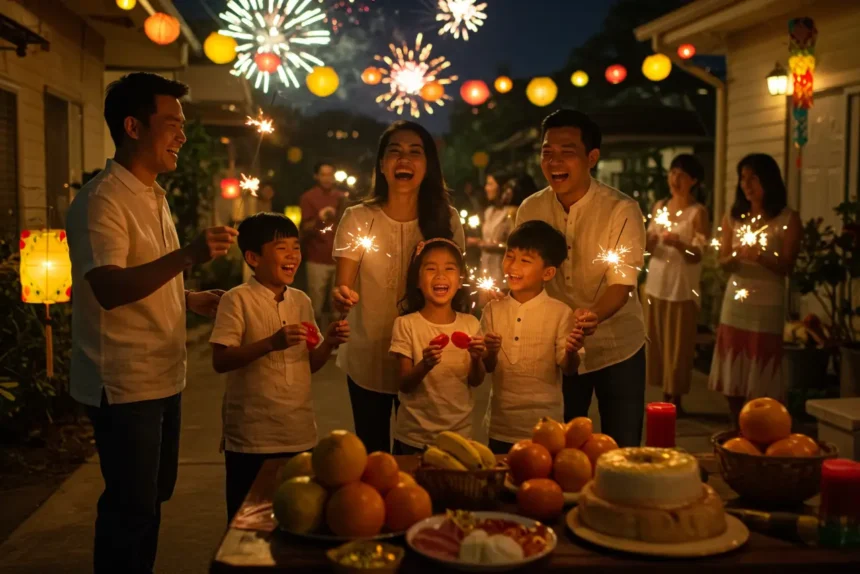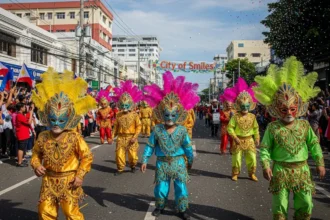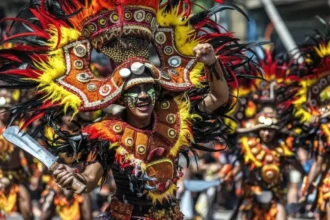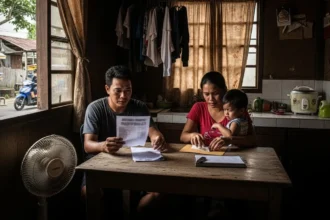If there’s one thing Filipinos know how to do best, it’s welcoming the New Year with ingay, kainan, and a whole lot of pamahiin. From jumping at midnight to wearing polka dots, our Filipino New Year traditions aren’t just fun – they’re deeply rooted in the belief that luck can be invited with the right rituals.
- 🎆 1. The Midnight Jump – “Para Tumangkad Ka!”
- 🍇 2. The 12 Round Fruits – Symbol of Abundance
- 👗 3. Polka Dots for Prosperity
- 🍽️ 4. The Media Noche Feast
- 🔊 5. Firecrackers and Noise-Making
- 💰 6. Filling Your Wallets and Pockets
- 🚪 7. Opening Doors and Windows at Midnight
- 👶 8. Avoiding Debt and Negative Energy
- 🧹 9. Sweeping Away Bad Luck
- 🏠 10. Lighting Every Corner of the House
- 💡 Modern Filipino Twists on New Year Traditions
- ❓FAQs About Filipino New Year Traditions
- 🌅 A Bright Start, the Filipino Way
- 🧭 References
Whether it’s the sound of firecrackers, the sweet spread of Media Noche, or the search for 12 perfectly round fruits, every family has their own way of attracting good fortune. Some may laugh it off, others swear by it – but one thing’s sure: New Year’s Eve in the Philippines always feels magical, maingay, and full of hope.
In this article, we’ll look at 10 lucky Filipino New Year customs, their meanings, and why they still matter to millions of Pinoys today – from big city fireworks to quiet probinsya celebrations.

🎆 1. The Midnight Jump – “Para Tumangkad Ka!”
If you grew up in the Philippines, you’ve probably done this at least once – jumping as high as you can at the stroke of midnight while your parents laugh (and warn you not to hit the ceiling fan). The tradition of jumping at midnight is one of the most famous pamahiin every New Year’s Eve, especially for kids and teens who dream of getting taller.
But where did this belief come from? While no one can pinpoint its exact origin, the idea is simple: height equals growth, and jumping into the new year symbolizes rising up to new heights – literally and figuratively. It’s a playful way to start the year full of energy, joy, and movement.
Some elders say it’s not just about physical height, but also about aspiration. The act of jumping is like saying, “I’m ready to reach higher this year.” For many Filipino families, it’s both a fun bonding moment and a symbolic wish for progress – in studies, career, love, or life in general.
And let’s be honest – even if you don’t grow a single inch taller, there’s something heartwarming about watching everyone jump and laugh together as fireworks explode outside. It’s one of those simple, chaotic, very Pinoy moments that make the New Year’s celebration so memorable.
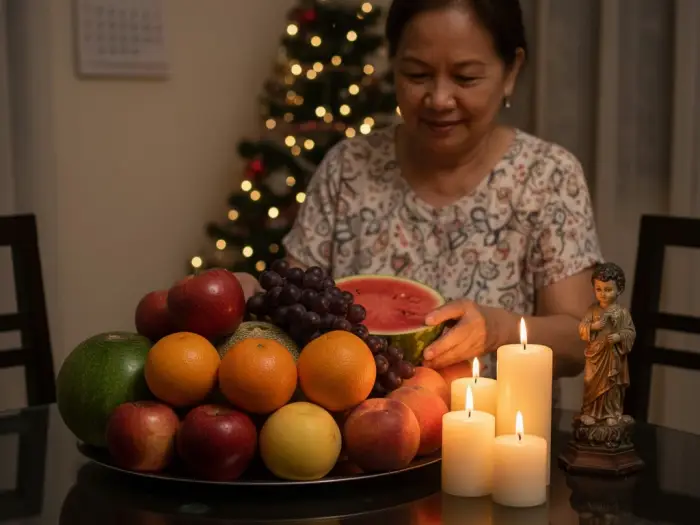
🍇 2. The 12 Round Fruits – Symbol of Abundance
No Filipino Media Noche table is ever complete without a colorful display of 12 round fruits. Some families even go the extra mile – talagang counting to make sure there are exactly twelve, one for every month of the coming year.
This beloved tradition traces its roots to Chinese influence, where round shapes symbolize coins, wealth, and continuous prosperity. Over time, Filipinos embraced it wholeheartedly, blending it with local customs and tropical flavors. The belief? If your table overflows with round fruits, your wallet won’t go empty for the next 12 months.
Most families start hunting for fruits as early as December 30, packing the dining table with grapes, apples, oranges, and whatever else looks “maswerte.” Some go for imported fruits for variety, while others stay practical and fill their baskets with local picks like dalanghita, pakwan, or melon.
It’s not just about superstition – it’s about the shared excitement of preparing for the year ahead. Every fruit becomes a small prayer for blessings: sweetness for happiness, abundance for food security, and health for the whole family.
Table: 12 Fruits & Their Meanings
| Fruit | Meaning | Common Substitute |
|---|---|---|
| Grapes | Wealth and luxury | Longan |
| Orange | Good fortune and energy | Dalanghita |
| Apple | Harmony and peace | Pear |
| Watermelon | Fertility and fullness | Melon |
| Banana | Family unity | Latundan |
| Pineapple | Success and opportunity | Canned pineapple |
| Mango | Sweet beginnings | Papaya |
| Guava | Good health | Guyabano |
| Lemon | Clarity and freshness | Calamansi |
| Pomegranate | Prosperity and blessings | Local lanzones |
| Melon | Calm and balance | Cantaloupe |
| Dragon fruit | Strength and endurance | Star apple |
Whether you believe in the luck or not, that burst of color and freshness on your Media Noche table makes the whole celebration feel abundant – parang ang saya lang tingnan!

👗 3. Polka Dots for Prosperity
If you’ve ever wondered why Tita Baby shows up on New Year’s Eve in a polka dot dress – or why Mama insists you wear one too – here’s the reason: polka dots mean prosperity.
This quirky Filipino New Year tradition comes from the same idea behind the 12 round fruits – circles represent coins, and coins mean pera. By wearing polka dots, you’re symbolically inviting money and good fortune to “stick” with you all year long.
Back in the day, women would prepare their polka dot outfits weeks before December 31, matching dresses, blouses, and even accessories. Some take it to the next level – round earrings, coin necklaces, or bags with dotted prints. Wala namang mawawala, ‘di ba?
Even men join the fun now, wearing dotted shirts or handkerchiefs tucked in their pockets. It’s a lighthearted way to embrace the spirit of optimism – that sense of “baka sakaling swertehin tayo this year.”
For many Filipinos, it’s not just fashion. It’s faith in the little things that make life mas masaya. You don’t have to believe in luck to enjoy the playfulness – because when the countdown begins and you’re surrounded by laughter, fireworks, and a sea of polka dots, it already feels like prosperity found its way to you.

🍽️ 4. The Media Noche Feast
After the fireworks and jumping, comes the real highlight of every Filipino New Year celebration – the Media Noche feast. It’s that long, laughter-filled meal that stretches past midnight, where plates are overflowing and everyone’s talking over each other about resolutions and tsismis.
The term Media Noche comes from the Spanish phrase meaning “midnight meal.” It’s the New Year’s counterpart to Noche Buena, which we celebrate during Christmas Eve. While Noche Buena focuses on family warmth and togetherness, Media Noche leans more on abundance – a symbolic feast to invite prosperity and blessings for the year ahead.
Typical Filipino Media Noche spreads include everything from lechon and hamon to pancit, keso de bola, biko, and fruits. Every dish has a deeper meaning – a silent wish for the coming year. Pancit for long life, sweet desserts for a sweet year, and round fruits for fortune.
Even families on a budget find creative ways to prepare a hearty Media Noche. Some cook spaghetti, fry lumpia, or grill tilapia – because the real essence isn’t luxury, but the spirit of sharing and gratitude. Kahit simple lang, basta sama-sama, busog pa rin ang puso.
Table: Common Media Noche Dishes & Their Symbolism
| Dish | Meaning | Region Popularity |
|---|---|---|
| Pancit or Spaghetti | Long life and continued blessings | Nationwide |
| Keso de Bola | Wealth and stability | Luzon |
| Lechon | Celebration and success | Visayas |
| Biko or Suman | Sweet year ahead | Mindanao |
| Hamon | Generosity and gratitude | Urban areas |
| Round Fruits | Prosperity and luck | Nationwide |
| Softdrinks & Wine | Joy and festivity | Nationwide |
| Fish (Tilapia, Bangus) | Bounty and progress | Rural communities |
More than a feast, Media Noche is a mirror of Filipino values – hope, family, and optimism. No matter how tough the past year was, the table always finds a way to be full again. And somehow, that’s the best sign that luck is already sitting with you.

🔊 5. Firecrackers and Noise-Making
Few sounds capture the Filipino New Year better than the putok-putok of firecrackers and the clanging of kaldero lids. From traditional rebentador to homemade torotot, the goal is the same – make as much noise as possible to drive away bad spirits and welcome a fresh start.
This belief, influenced by ancient Chinese customs, stems from the idea that evil entities fear loud sounds. So when midnight strikes, the entire neighborhood erupts in chaos – fireworks lighting the sky, neighbors banging pots and pans, tricycles honking, and kids blowing plastic horns until their cheeks hurt.
In recent years, stricter regulations and safety concerns have made many families shift to safer (and quieter) celebrations. Instead of firecrackers, some turn up their karaoke, play loud music, or rev motorcycle engines sabay tawa-tawa. Others join community fireworks displays to avoid accidents while still keeping the festive energy alive.
For Filipinos, it’s not just about noise – it’s about cleansing the air of negativity and starting the year bright, loud, and joyful. The explosion of sound becomes a shared release – lahat ng stress ng nakaraang taon, ilabas na! When the smoke clears and the streets fall quiet again, you can almost feel it: the calm of a brand new beginning.
💰 6. Filling Your Wallets and Pockets
Before the clock hits twelve, many Filipinos secretly slip a few crisp bills into their wallets and pockets – because as the saying goes, “Kung anong laman ng bulsa mo sa Bagong Taon, ‘yan din ang laman buong taon.”
This charming pamahiin is based on the idea that starting the year with money attracts financial abundance. It’s not just superstition – it’s also a way of manifesting hope and readiness for prosperity. Some even make sure their wallets are organized, with bills facing the same direction (a sign of respect for money, as elders say).
Parents often remind their kids, “Huwag kang lalabas na walang laman ang bulsa mo!” – believing that an empty pocket might symbolize scarcity or financial struggles ahead. Others even fill piggy banks or coin jars, representing savings goals for the coming year.
Interestingly, this tradition blends practical and symbolic meaning. Beyond luck, it teaches a deeper message: start the year prepared, not pabigla-bigla. For many, it’s not just about the cash – it’s about the mindset of abundance and discipline.
And when you think about it, there’s something beautifully simple about it – the quiet confidence of walking into the new year with a full wallet and an even fuller sense of hope.
🚪 7. Opening Doors and Windows at Midnight
When the clock strikes twelve, some Filipino households swing open their doors and windows wide – a symbolic gesture to let good fortune and positive energy flow in. It’s a quiet but powerful ritual, especially in the provinces where families believe that the New Year breeze carries blessings.
The idea is simple: by keeping your home open, you’re showing the universe that you’re ready to receive abundance. Sabi nga ng matatanda, if you close your doors during midnight, you might also be “closing out” the luck that’s trying to come in.
You’ll often see parents rushing to unlock doors and windows right after the fireworks begin, while kids run around with sparklers, laughing as the night air mixes with smoke and music. It’s a small, almost poetic moment – as if the whole house is taking a deep breath of new beginnings.
In modern apartments or condos, families get creative. They open balcony doors, raise curtains, or even turn on electric fans to “keep the air flowing.” Whether literal or symbolic, this tradition captures what every Filipino heart feels at the turn of the year – that hope should never be shut out.

👶 8. Avoiding Debt and Negative Energy
“Bayaran mo muna bago mag-New Year!” – you’ve probably heard this at least once before. In many Filipino homes, it’s considered bad luck to start the year with unpaid debts or lingering conflicts.
This New Year’s belief isn’t just superstition – it reflects our deep cultural value of pagrespeto and pag-aayos ng loob. Settling debts and forgiving grudges before January 1 symbolizes emotional and financial cleansing. It’s like saying, “Ayoko nang bitbitin ‘yung bigat ng nakaraang taon.”
Some even avoid borrowing or lending money during the last few days of December, believing that it could lead to financial struggles all year long. Meanwhile, others take the time to reconcile with family or friends – clearing the air before the year resets.
In truth, this custom encourages accountability and peace. After all, what better way to start the year than with a light heart, a clean slate, and zero utang? Because when you welcome January 1 debt-free – in both wallet and spirit – it feels like life’s giving you permission to start fresh.
🧹 9. Sweeping Away Bad Luck
If you’ve ever been scolded for sweeping right after midnight, you’re not alone. In many Filipino households, broomsticks are off-limits once the clock hits twelve – because according to pamahiin, sweeping at the start of the year means you’re “sweeping away” the blessings that just arrived.
This belief likely stems from Chinese traditions around cleansing and luck. The idea is that fortune flows into your home during Media Noche, and sweeping too soon drives it away before it can settle. That’s why you’ll often hear Nanay say, “Bukas mo na lang walisin ‘yan!” – even if confetti, dust, and spilled spaghetti are already everywhere.
Some families take it a step further: they clean thoroughly on December 30 or 31, making sure the house is spotless before the New Year comes. Then, once midnight passes, the broom rests – untouched – until morning.
It’s both funny and practical, really. The “no sweeping” rule gives everyone a valid excuse to relax, sit back, and enjoy the leftovers after all the putukan. And maybe, just maybe, that pause – that decision to stop cleaning and start celebrating – is its own kind of luck.

🏠 10. Lighting Every Corner of the House
As the New Year approaches, many Filipino families make sure every light in the house is turned on – from the sala lamp to the kitchen bulb and even the tiny night light in the bathroom. The reason? It’s believed that a well-lit home invites a bright, lucky, and prosperous year ahead.
This tradition symbolizes hope and positivity. Light represents life, clarity, and energy – and in Filipino culture, darkness often equates to misfortune or sadness. So when midnight comes, lahat ng ilaw bukas, filling homes with warmth and a sense of renewal.
Some families even take it further by lighting candles or small lamps, especially in areas that are usually dim or quiet. The glow isn’t just physical – it’s emotional, too. It’s a reminder to keep faith alive, to illuminate even the parts of our lives that felt uncertain in the past year.
In the provinces, it’s common to see houses glowing softly under the stars, while in the city, apartment windows shimmer like lanterns across the skyline. It’s a beautiful sight – a thousand little beacons saying the same thing: “We’re ready for a brighter year.”
Whether you believe in luck or not, there’s something comforting about that warm, golden light on January 1. It’s the Filipino way of declaring, “Hindi man perpekto ang taon, kakayanin natin – may liwanag pa rin.”
💡 Modern Filipino Twists on New Year Traditions
Times are changing, and so are the ways Filipinos celebrate the New Year. While Media Noche, firecrackers, and polka dots remain classic staples, the modern Pinoy has found creative – and sometimes eco-friendly – ways to keep the traditions alive without the mess or danger.
These days, many families skip the paputok entirely and join community fireworks displays instead. Others switch to digital countdowns, streaming live concerts or fireworks shows online while video calling loved ones abroad. Even the torotot has gone digital – apps that simulate firecracker sounds are now a thing!
You’ll also see younger Filipinos putting a minimalist spin on things: instead of 12 fruits, they’ll decorate with 12 round décor pieces or fruit emojis for fun. Some replace physical coins with e-wallet savings, saying “Gcash is the new bulsa.”
What hasn’t changed, though, is the heart behind it all – the Filipino hope for a fresh start. Whether through a quiet dinner, a karaoke marathon, or a virtual toast with relatives overseas, the essence remains: to welcome the year with joy, connection, and a belief that life can always get better.
Because at the end of the day, it doesn’t matter if you’re lighting fireworks or just lighting your phone screen – what counts is the light you carry moving forward.
❓FAQs About Filipino New Year Traditions
-
What are the most common Filipino New Year traditions?
Most Filipino families follow customs like Media Noche, wearing polka dots, displaying 12 round fruits, and making noise at midnight to attract good luck and drive away bad spirits. -
Why do Filipinos jump at midnight on New Year’s Eve?
Jumping at midnight is believed to help kids grow taller, but it also symbolizes reaching higher goals and starting the year full of energy and optimism. -
What is the meaning of the 12 round fruits during Media Noche?
Each round fruit represents one month of prosperity, and the circular shape symbolizes wealth and continuous blessings for the entire year. -
What’s the difference between Noche Buena and Media Noche?
Noche Buena is celebrated on Christmas Eve to honor family and faith, while Media Noche happens on New Year’s Eve and focuses on abundance, luck, and renewal. -
Why do people wear polka dots on New Year’s Eve?
The round polka dot design symbolizes coins and wealth, so wearing it is thought to attract prosperity and financial blessings. -
Is it true you shouldn’t sweep or clean right after midnight?
Yes, many Filipinos believe that sweeping after midnight can drive away good fortune that just entered your home, so cleaning waits until the next morning. -
Why do Filipinos make so much noise during New Year?
Noise from paputok, torotot, or banging pots and pans is believed to scare away evil spirits and start the year with lively, positive energy. -
Why should you keep your pockets and wallets full on New Year’s Eve?
It’s believed that having money in your pocket as the year begins attracts wealth and financial stability throughout the coming months. -
Why do some people open their doors and windows at midnight?
Opening doors and windows symbolizes welcoming good luck and blessings into the home – a way to “invite” fortune to come in freely. -
What modern Filipino New Year traditions are popular today?
Many now celebrate with online countdowns, eco-friendly noise makers, or digital fireworks – blending classic beliefs with modern, safer fun.

🌅 A Bright Start, the Filipino Way
Every New Year’s Eve in the Philippines feels like a celebration of pag-asa. Whether you’re jumping at midnight, lighting every corner of the house, or sharing biko with family, these traditions remind us of what truly matters – faith, togetherness, and the belief that life always renews itself.
We may laugh about the pamahiin, but deep down, each custom carries a wish: that the year ahead will be kinder, brighter, and more abundant than the last. And that’s the magic of the Filipino spirit – turning simple acts into powerful symbols of hope.
So as you greet another year, don’t worry if your fruits aren’t perfectly round or your polka dots don’t match. What counts is the laughter around the table, the warmth of home, and that spark inside you that says, “Kaya ko ‘to. This year will be better.”
Because in true Pinoy fashion – we don’t just wait for luck; we welcome it with open arms, full plates, and brighter hearts.
🧭 References
-
Agoda Travel Guides – New Year’s Eve Traditions in the Philippines
-
Owlcation – Filipino Traditions on New Year’s Eve
-
Inquirer.net – 10 Filipino New Year Traditions to Bring Luck and Prosperity
-
DiscoverPhilippines.org – How Filipinos Welcome the New Year
-
BarongTagalogStore.com – Filipino New Year Traditions You Should Know



